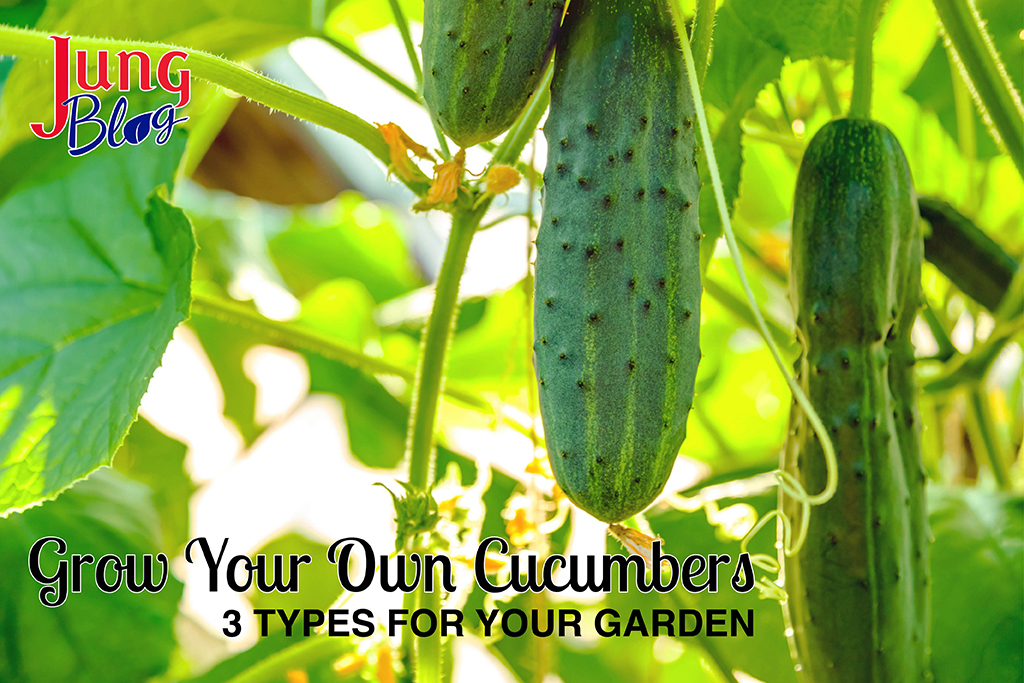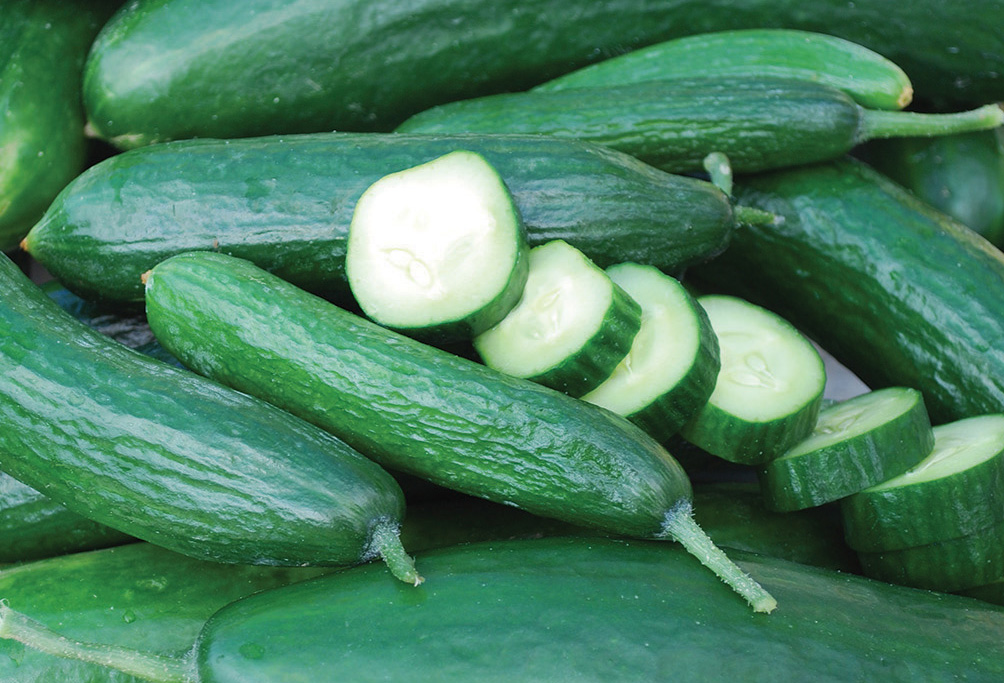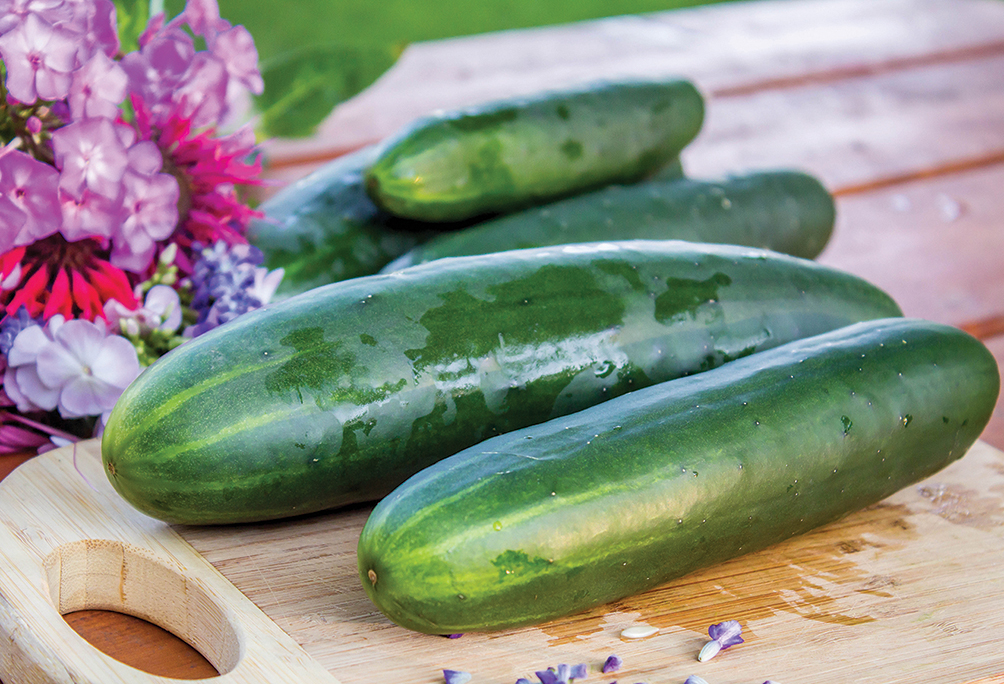
Cucumber breeders have been busy, in the last few decades, trying to limit bitter taste, increase yields, and breed more disease resistance into their plants.
There are now three cucumber varieties commonly available; Monoecious, Gynoecious, and Parthenocarpic. Each has its own specific qualities that will appeal to certain kinds of gardeners and growers.
Monoecious

What Are Monoecious Cucumbers?
Monoecious types are plants that produce both male and female flowers on the same plant.
Monoecious Varieties
Examples of monoecious Jung Seed Co. cucumber varieties are; ‘Homemade Pickles’, ‘Muncher’, and ‘Spacemaster 80 Bush’. Most heritage and heirloom-type cucumber varieties are monoecious. They are perfect varieties for both home gardeners and farm market growers.
Male vs Female Cucumbers
Ladies first, is what my parents taught me but with cucumber vines, male flowers are usually produced first. If you are paying attention to this fact, you may get concerned because only female flowers make the fruit, but this is entirely normal for cucurbit family members. Plants put all their early energy to produce male flowers to attract pollinators. Think of it as a dress rehearsal. Female flowers will develop later when plenty of pollen is already available.
Monoecious type cucumber plants will eventually have equal numbers of male to female flowers on the same plants. Occasionally you may see a designation of “PF” on a monoecious cucumber variety listing. This stands for “Primarily Female”. A plant that naturally produces predominantly female flowers and fewer male flowers. The same environmental stresses will still affect flower and fruit development on “PF” plants.
Tips For Monoecious
Growing Conditions
However, growing conditions in the early stages are critical. Getting plants started in a timely manner makes a huge difference because higher daytime temperatures induce plants to produce more male flowers and fewer female flowers. You can’t change this fact. Savvy gardeners will use Hot Kaps® Plant Protectors to aid early plant development. This is the single most useful trick to getting plants started early and getting them going. Hot Kaps® keep heat in, frost off, and bugs out!
Preventing Plant Stress
Preventing plant stress is also very important because it not only causes delay or reduction in the number of female flowers, but it will cause fruits to drop. Pay close attention to these few crucial things –
- Plant spacing. Plants that are too close together compete for water, nutrients, and sun, causing stress.
- Wind. Windy conditions cause stress on developing plants.
- Insect damage. Watch for squash bugs, cucumber beetles, cutworms, and nematodes. As plants mature, trade your Hot Kaps® for Floating Row Covers to deter insect predation.
- Low light. The more sun the better for female cucurbit flower production.
- Water stress. Keep water consistent to avoid any issues.
Gynoecious

What Are Gynoecious Cucumbers?
Gynoecious cucumber plants produce only female flowers. These breeds have large numbers of female flowers but over a shorter period of growing time. These work well for larger growers who want to get their crop in and off in a shorter window to move on to the next crop. In contrast, a monoecious plant’s fruiting season will be spread out over several pickings.
Why Choose Gynoecious Cucumbers?
Gynoecious varieties may work well for a one-and-done crop system. Female flowers still need pollen from a male flower, so individual seed packs of gynoecious varieties do already contain an optimal blend, usually with 10-15% seeds of monoecious flowering plants for this pollination to occur in the garden. Here is the rule for you to memorize; nearly all parthenocarpic cucumbers are gynoecious but not all gynoecious types are parthenocarpic.
Gynoecious Varieties
Here are some excellent selections of all-female flowered varieties; ‘Gherking’ hybrid, ‘Mini Much’, and ‘Sweet Success’ all of which are gynoecious and happen to be parthenocarpic.
Parthenocarpic

What Are Parthenocarpic Cucumbers?
Parthenocarpic cucumber varieties do not require a transfer of pollen from one flower to another to set fruit. Fruits produced from these plants are virtually seedless. However, if parthenocarpic blooms are cross-pollinated with other types their fruits may produce seeds. If the seedless aspect of your parthenocarpic cucumber fruit is important, plants should be isolated in the garden.
Why Choose Parthenocarpic Cucumbers?
These modern varieties of cucumbers are a huge advantage to commercial or greenhouse growers who grow crops indoors to prevent pest invasions and have better overall climate controls but don’t have free-flying pollinators inside. Even in backyard growing situations where you choose to leave Floating Row Covers on all season to restrict insect pressure, parthenocarpic cucumber flowers can produce fruit, without pollinator visitations. That is, as long as all their other cultural requirements are met.
Parthenocarpic Varieties
Some excellent parthenocarpic varieties to look for are the ‘County Fair Improved’ hybrid, ‘Diva’ hybrid, and ‘Goliath’ hybrid.
Tips For Parthenocapric
As with all other cucumbers, cultural and environmental stresses can adversely affect parthenocarpic plants from producing fruit. In a nutshell, parthenocarpy is hormone-dependent, and plants that don’t produce the correct levels of hormones have trouble holding their fruits on the vine. The evolution of fruit is producing seeds to carry on the species. If plants are stressed, no hormones are produced and they will abort their fruit because signals in the plant contend that conditions are not correct for seed dispersal, so they drop their fruit. High temperatures, lack of adequate soil nutrition, and soil moisture are the three most common causes in this specific instance.

This is a lot of detailed information, don’t get too bogged down about which ones are gynoecious or parthenocarpic. It is good to know what these definitions mean but choose a variety for your desired culinary needs, such as; Slicer, pickler, or one type for both, and then the growth habit of the plant. No matter how the fruits are produced, cucumber plants require the same cultural care and environmental conditions to do really well and not yield bitter fruits.
Other Recommended Reading

- Growing Vegetables Indoors From Seed
- Seed Saving: 4 Important Questions To Consider Before Starting
- 22 Easy To Grow Vegetable Seeds
- 14 Fast Growing Vegetables
- Companion Planting Guide
At Jung Seed Co, we strive to be your go-to guide for all your gardening needs. Our YouTube channel Jung Garden Center now includes our new video series All Things Green where our experts provide gardening tips for all levels of gardeners. When you need reliable gardening advice, turn to the trusted experts at Jung.
View our new catalog online or browse our website for all of your gardening favorites. To receive info on new products, exclusive deals, and specials, be sure to sign up for our weekly email. Join our Facebook page, to discuss all things gardening!
